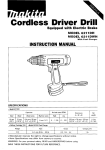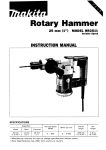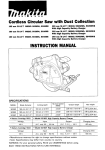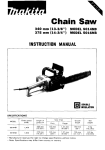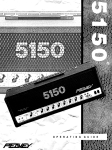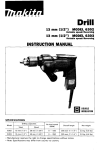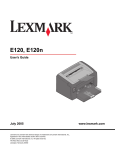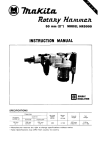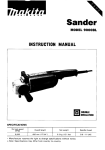Download Makita 6311DW Instruction manual
Transcript
Equipped with Electric Brake
MODEL 6311D
MODEL 6311DW
With Fast Charger
INSTRUCTION MANUAL
No load speed IRPMl
Capacities
Steel
13"
1112")
1
Wood
24"
115116"l
I
6.4mmx55mm
1114" x 2-3/16")
Battery Cartridge 1200
Voltage
12 v
I
Wood screw
I
Machine screw
Hiqh
op
6mm11,4,,)
,,150
I
Dimensions
1L x W x HI
Net
weight
244mmx79mmx233mm
19-518" x 3-118" x 9-114")
14.3 Ibs)
tow
o-370
1.95kg
Model DC1290 Fast Charger
I
1
Input
A.C. only 50 Hz - 60 Hz
~
~
~
~
I
I
output
D.C. 9.6 V. 12 V
1
I
~~~~~~~~~
Manufacturer reserves the right to change specifications without notice.
Note: Specifications may differ from country to country.
WARNING: For your personal safety, READ and UNDERSTAND before using.
SAVE THESE INSTRUCTIONS FOR FUTURE REFERENCE.
charging time
1 Hr
IMPORTANT
SAFETY INSTRUCTIONS
(For All Tools)
WARNING: WHEN USING ELECTRIC TOOLS, BASIC SAFETY
PRECAUTIONS SHOULD ALWAYS BE FOLLOWED TO REDUCE
THE RISK OF FIRE, ELECTRIC SHOCK, AND PERSONAL
INJURY, INCLUDING THE FOLLOWING:
READ ALL INSTRUCTIONS.
~~~~
1. KEEP WORK AREA CLEAN. Cluttered areas and benches invite injuries.
2. CONSIDER WORK AREA ENVIRONMENT. Don't use power tools in damp
or wet locations. Keep work area well lit. Don't expose power tools t o rain.
Don't use tool in presence of flammable liquids or gases.
3.KEEP CHILDREN AWAY. All visitors should be kept away from work area.
Don't let visitors contact tool or extension cord.
4. STORE IDLE TOOLS. When not in use, tools should be stored in dry, and high
or locked-up place - out of reach of children.
5. DON'T FORCE TOOL. It will do the job better and safer at the rate for which
it was intended.
6. USE RIGHT TOOL. Don't force small tool or attachment t o do the job of a
heavy-duty tool. Don't use tool for purpose not intended; for example, don't
use circular saw for cutting tree limbs or logs.
7. DRESS PROPERLY. Don't wear loose clothing or jewelry. They can be caught
in moving parts. Rubber gloves and non-skid footwear are recommended
when working outdoors. Wear protective hair covering t o contain long hair.
8. USE SAFETY GLASSES. Also use face or dust mask if cutting operation is
dusty.
9. DON'T ABUSE CORD. Never carry tool by cord or yank it t o disconnect from
receptacle. Keep cord from heat, oil, and sharp edges.
IO. SECURE WORK. Use clamps or a vise to hold work. It's safer than using
your hand and it frees both hands t o operate tool.
11. DON'T OVERREACH. Keep proper footing and balance at all times.
12. MAINTAIN TOOLS WITH CARE. Keep tools sharp and clean for better and
safer performance. Follow instructions for lubricating and changing accessories. Inspect tool cords periodically and if damaged, have repaired by authorized service facility. Inspect extension cords periodically and replace if
damaged. Keep handles dry, clean, and free from oil and grease.
13. DISCONNECT TOOLS. When not in use, before servicing, and when changing accessories, such as blades, bits, cutters.
KEYLESS CHUCK SYSTEM
This cordless driver drill is now equipped with a”&&‘
system.
Keyless Chuck
This Keyless Chuck features a click locking mechanism to reduce
loosening of the bit from vibration, in addition to making the bit faster and
easier to install.
Below are the instructions for using the “New“keyless chuck. This
sheet supersedes the “Installing or Removing Driver Bit or Drill Bit”
section on Page 7 of the instruction manual.
Installing or removing driver bit or drill bit
CAUTION:
Always be sure that the tool is switched off and the battery cartridge is
removed before installing or removing the bit.
Hold the ring and turn the
sleeve counterclockwise to
open the chuck jaws. Place
the bit in the chuck as far as it
will go. Hold the ring firmly and
turn the sleeve clockwise to
tighten the chuck. Chuck is
locking when you hear a slight
clicking sound.
To unlock and remove the bit,
hold the ring and turn the
sleeve counterclockwise.
This tool contains 12V High Capacity Battery 1201 and Charger DC1201.
CAUTION - To reduce risk of injury, charge only appropriate MAKITA Ni-Cd batteries. Other
types of batteries may burst causing personal injury and damage.
This insert page supersedes Page 6 and Page 12 from the enclosed instruction manual.
Charging
Your new battery cartridge is not charged.
You will need to charge it before use. Use
the fast charger Model DC1201 to charge
the battery cartridge.
*Plug the fast charger into the proper A/C
voltage source. The charging light will
flash in green color.
Charging light
-
*Insert the battery cartridge so that the
plus and minus terminals on the battery
cartridge are on the same sides as their
respective markings on the fast charger.
Insert the cartridge fully into the port so that it rests on the charger port floor.
*When the battery cartridge is inserted, the charging light color will change from green t o
red and charging will begin. The charging light will remain lit steadily during charging.
*When charging is completed, the charging light color will change from red t o green and
a tone will sound steadily for about 5 seconds. The charging time is approximately one
hour.
*After charging, unplug the charger from the power source.
CAUTION :
*The fast charger Model DC1201 is for charging Makita battery cartridge. Never use it for
other purposes or for other manufacturer's batteries.
*When you charge a new battery cartridge or a battery cartridge which has not been used
for a long period of time, it may not accept a full charge. This is a normal condition and
does not indicate a problem. You can recharge the battery cartridge fully after discharging it completely and recharging a couple of times.
If you charge a battery cartridge from a just-operated tool or a battery cartridge which
has been left in a location exposed to direct sunlight or heat for a long time, the charging light may flash in red color. If this occurs, wait for a while. Charging will begin after
the battery cartridge cools. The battery cartridge will cool faster if you remove the
battery cartridge from the fast charger.
If the charging light flashes alternately in green and red color and a tone sounds "beep,
beep, beep, . . ." for about 20 seconds, a problem exists and charging i s not possible.
The terminals on the charger or battery cartridge are clogged with dust or the battery
cartridge is worn out or damaged.
- I f you wish to charge two battery cartridges, allow 15 minutes between chargings on the
fast charger.
6
ACCESSORIES
CAUTION:
These accessories or attachments are recommended for use with your Makita tool specified in this
manual. The use of any other accessories or attachments might present a risk of injury to persons.
The accessories or attachments should be used only in the proper and intended manner.
Fast charger
Bits
I
Size
I
Part No.
Model DC1201
Part No. 1 131 26-0
Phillips
-
Slotted
3J%-fzE&
Square drill bit
784606-0A
Battery cartridge 1200
Part No. 192271-4
Rubber pad assembly
High capacity battery 1201
Part No. 123001-2
Part No. 192296-8
Foam polishing pad
Power display battery (High cap.) 1201A
Part No. 743023-2
Part No. 192407-5
Wool bonnet
Battery cover
Part No. 743401-6
Part No. 414938-7
Plastic carrying case
Belt clip
Part No. 343951 - 7
12
14. REMOVE ADJUSTING KEYS AND WRENCHES. Form habit of checking t o
see that keys and adjusting wrenches are removed from tool before turning
it on.
15. AVOID UNINTENTIONAL STARTING. Don't carry tool with finger on switch.
Be sure switch is OFF when plugging in.
16. OUTDOOR USE EXTENSION CORDS. When tool is used outdoors, use only
extension cords intended for use outdoors and so marked.
17. STAY ALERT. Watch what you are doing, use common sense. Don't operate
tool when you are tired.
18. CHECK DAMAGED PARTS. Before further use of the tool, a guard or other
part that is damaged should be carefully checked t o determine that it will
operate properly and perform its intended function. Check for alignment of
moving parts, binding of moving parts, breakage of parts, mounting, and any
other conditions that may affect its operation. A guard or other part that
is damaged should be properly repaired or replaced by an authorized service
center unless otherwise indicated elsewhere in this instruction manual. Have
defective switches replaced by authorized service center. Don't use tool if
switch does not turn it on and off.
19. GUARD AGAINST ELECTRIC SHOCK. Prevent body contact w i t h grounded
surfaces. For example; pipes, radiators, ranges, refrigerator enclosures.
20. REPLACEMENT PARTS. When servicing, use only identical replacement parts.
21. POLARIZED PLUGS. To reduce the risk of electric shock, this equipment has
a polarized plug (one blade is wider than the other). This plug will fit in a
polarized outlet only one way. If the plug does not fit fully in the outlet, reverse
the plug. If it still does not fit, contact a qualified electrician t o install the
proper outlet. Do not change the plug in any way.
VOLTAGE WARNING: Before connecting the tool t o a power source (receptacle,
outlet, etc.) be sure the voltage supplied is the same as that specified on the
nameplate of the tool. A power source with voltage greater than that specified
for the tool can result in SERIOUS INJURY t o the user - as well as damage t o
the tool. If in doubt, DO NOT PLUG IN THE TOOL. Using a power source with
voltage less than the nameplate rating is harmful t o the motor.
3
IMPORTANT SAFETY INSTRUCTIONS
FOR CHARGER &
BATTERY CARTRIDGE
I. SAVE THESE INSTRUCTIONS - This manual
contains important safety and operating instructions for battery charger.
2.Before using battery charger, read all instructions and cautionary markings
on (1) battery charger, (2)battery, and (3)product using battery.
3.CAUTION - To reduce risk of injury, charge only MAKITA Battery Cartridge
9000,9100,1200,1210& 1211.Other types of batteries may burst causing
personal injury and damage.
4. Do not expose charger t o rain or snow.
5. Use of an attachment not recommended or sold by the battery charger
manufacturer may result in a risk of fire, electric shock, or injury t o persons.
6. To reduce risk of damage to electric plug and cord, pull by plug rather than
cord when disconnecting charger.
7. Make sure cord is located so that it will not be stepped on, tripped over, or
otherwise subjected t o damage or stress.
8.An extension cord should not be used unless absolutely necessary. Use of
improper extension cord could result in a risk of fire and electric shock. If
extension cord must be used, make sure:
a. That pins on plug of extension cord are the same number, size, and shape
as those of plug on charger;
b. That extension cord is properly wired and in good electrical condition; and
c. That wire size is at least as large as the one specified in the table below.
TABLE 1
RECOMMENDED MINIMUM AWG SIZE FOR
EXTENSION CORDS FOR BATTERY CHARGERS
Length of Cord (Feet)
AWG Size of Cord
25
18
50
18
100
18
150
16
9. Do not operate charger with damaged cord or plug - replace them immediately.
IO.Do not operate charger if it has received a sharp blow, been dropped,
or otherwise damaged in any way; take it t o a qualified serviceman.
11. Do not disassemble charger or battery cartridge; take it t o a qualified
serviceman when service or repair is required. Incorrect reassembly may
result in a risk of electric shock or fire.
12.To reduce risk of electric shock, unplug charger from outlet before attempting any maintenance or cleaning. Turning off controls will not reduce this risk.
4
ADDITIONAL SAFETY RULES
FOR CHARGER & BATTERY CARTRIDGE
1. Do not charge Battery Cartridge when temperature is BELOW 10°C (5OOF)
or ABOVE 4OoC (104OF).
2. Do not attempt t o use a step-up transformer, an engine generator or DC power
receptacle.
3.Do not allow anything t o cover or clog the charger vents.
4. Always cover the battery terminals with the battery cover when the battery
cartridge is not used.
5. A battery short can cause a large current flow, overheating, possible burns
and even a breakdown.
(11 Do not touch the terminals with any conductive material.
(2)Avoid storing battery cartridge in a container with other metal objects such
as nails, coins, etc.
(3)Do not expose battery cartridge t o water or rain.
6. Do not store the tool and Battery Cartridge in locations where the temperature
may reach or exceed 5OoC (122OF).
7. Do not incinerate the Battery Cartridge even if it is severely damaged or is
completely worn out. The battery cartridge can explode in a fire.
ADDITIONAL SAFETY RULES
1. Be aware that this tool is always in an operating condition, because it does
not have t o be plugged into an electrical outlet.
2. Always be sure you have a firm footing.
Be sure no one is below when using the tool in high locations.
3. Hold the tool firmly.
4. Keep hands away from rotating parts.
5. When drilling into walls, floors or wherever "live" electrical wires may be
encountered, DO NOT TOUCH ANY METAL PARTS OF THE TOOL!
Hold the tool only by the insulated grasping surfaces t o prevent electric shock
if you drill into a "live" wire.
6.Do not leave the tool running. Operate the tool only when hand-held.
7. Do not touch the drill bit or the workpiece immediately after operation; they
may be extremely hot and could burn your skin.
SAVE THESE INSTRUCTIONS.
5
Installing or removing battery cartridge
Always switch off the tool before insertion or removal or the battery cartridge.
0
.To remove the battery cartridge, pull out
the set plate on the tool and grasp both
sides of the cartridge while withdrawing it
from the tool.
.To insert the battery cartridge, align the
tongue on the battery cartridge with the
groove in the housing and slip it into
place. Snap the set plate back into place.
Be sure to close the set plate fully before
using the tool.
0
Do not use force when inserting the battery cartridge.
If the cartridge does not slide in easily, it is not being inserted correctly.
m
Charging
Battery cartridge
Plug the fast charger into your power
source. Insert the battery cartridge so that
the plus and minus terminals on the battery cartridge are on the same sides as their
respective markings on the fast charger.
Insert the cartridge fully into the port so
that it rests on the charger port floor.
Press the start button (red). The charging
Reset button
light will come on and charging will begin.
If the charging light does not come on, press the reset button (yellow) first, then the start
button (red). If the charging light goes out within 10 seconds even after pressing the
reset button and start button a couple of times, the battery cartridge is dead. (CAUTION:
Wait for more than 5 seconds after the charging light goes out to press the reset button
again.) Replace it with a new one. When the charging light goes out after about one our,
you may remove the fully charged battery cartridge.
After charging, unplug the charge from the power source.
CAUTION :
Your new battery cartridge is not charged. You will need to charge it before use.
0 When you charge a new battery cartridge or a battery cartridge which has not been used
for a long period of time, the charging light may not come on. If this occurs, iust press
the reset button (yellow) first, then the start button (red) as described before. Charging
will begin.
0 Do not keep the button pressed in with tape, etc. or the circuit will not function properly. Also, a malfunction of the charger may result possibly causing overheating, etc.
0 If you try to charge a cartridge from a just-operated tool, sometimes the charging light
will not come on. If this occurs, let the cartridge cool off for a while. Then re-insert it
and try to charge it once more.
0 When you charge a new battery cartridge or a battery cargridge which has not been used
for a long period, it may not accept a full charge. This is a normal condition and does
not indicate a problem. You can recharge the battery cartridge fully after discharging
it almost completely a couple of times.
0 If you wish to charge two battery cartridges, allow 15 minutes between chargings on the
fast charger.
0
6
installing or removing driver bit or drill b i t
CAUTION:
Always be sure that the tool is switched off and the battery cartridge is removed before
instaliing or removing the bit.
Hold the ring and turn the sleeve counterclockwise to open the chuck jaws. Place
the bit in the chuck as far as it will go.
Hold the ring firmly and turn the sleeve
clockwise t o tighten the chuck.
To remove the bit, hold the ring and turn
the sleeve counterclockwise.
I
Sleeve
Switch action
Tool speed is increased by increasing pressure on the trigger. To start the tool, simply
pull the trigger. Release the trigger to stop.
CAUTION :
Before inserting the battery cartridge into the tool, always check t o see that the switch
trigger actuates properly and returns t o the "OFF" position when released.
Reversing switch action
This tool has a reversing switch to change
the direction of rotation. Slide the reversing switch to the left for clockwise rotation or t o the right for counterclockwise.
CAUTION:
Always check the direction of rotation before operation.
.Move the reversing switch only after the tool comes t o a complete stop. Changing the
direction of rotation before the tool stops may damage the tool.
0
7
Speed change
To change the speed, slide the speed change
lever to the "H" side for high speed or
"L" side for low speed. To slide the speed
change lever easily, pull the trigger slightly
while pushing the speed change lever. Be
sure that the speed change lever is set to
the correct position before operation. Use
the right speed for your job.
CAUTION:
Always set the speed change lever fully into the correct position. If you operate the tool
with the speed change lever positioned halfway between the "H" side and "L" side, the
tool may be damaged.
Adjusting fastening torque
Pointer
7
Drill marking
The fastening torque can be adjusted in six
stages by turning the adjusting ring so that
the pointer on the adjusting ring points to
a number on the tool body. The fastening
torque is minimum when the pointer points
to the number 1 and maximum when it
points to the a\- marking. The clutch will
slip at varying torque levels when the
pointer is set a t the numbers 1 to 5. The
clutch is designed not to slip a t the
markina.
Before-actual operation, drive a trial screw into your material or a piece of duplicate
material to determine which torque level is required for a particular application.
7
NOTE :
The adjusting ring cannot be locked with the pointer positioned half-way between the
numbers.
Screwdrivingoperation
Place the point of the driver bit in the
screw head and apply pressure to the tool.
Start the tool slowly and then increase the
speed gradually. Release the trigger as soon
as the clutch cuts in.
8
NOTE :
Make sure that the driver bit is inserted straight in the screw head, or the screw and/or
bit may be damaged.
0
When driving wood screws, predrill pilot
holes to make driving easier. and to prevent splitting
- of the workpiece. See the
chart.
Nominal diameter of
wood Screw ("1
3.1 (118")
I
I
I
Recommended size
of pilot hole I n "
2.0 - 2.2 (5164'' - 3/32")
3.5 (9164")
2.2 - 2.5 (3132'' - 3/32")
3.8 (5132")
4.5 111164"l
4.8 (3116")
2.5 - 2.8 (3132'' - 7/64',)
2.9 - 3.2 (7164" - 118")
5.1 (13164")
5.5 17/32',)
5.8 17/32',)
6.1 115164")
6.4 1114")
I
3.1 - 3.4 (118'' - 9164")
3.3 - 3.6 (118" - 9/64',)
3 7 - 3.9 19164" - 5/32',)
4.0 - 4.2 15/32'' - 11/64")
I
4.2 - 4.4 11 1/64" - 11/64',)
4.4 - 4.6 I1 1/64" - 6/32',)
I
Drilling operation
First, turn the adjusting ring so that the pointer on the adjusting ring points to the
marking. Then proceed as follows.
0
0
-\-
Drilling in wood
When drilling in wood, best results are obtained with wood drills equipped with a guide
screw. The guide screw makes drilling easier by pulling the bit into the workpiece.
Drilling in metal
To prevent the bit from slipping when starting a hole, make an indentation with a centerpunch and hammer a t the point to be drilled place the point of the bit in the indentation and start drilling.
Use a cutting lubricant when drilling metals. The exceptions are iron and brass which
should be drilled dry.
CAUTION :
*Pressing excessively on the tool will not speed up the drilling. In fact, this excessive
pressure will only serve to damage the tip of your bit, decrease the tool performance
and shorten the service life of the tool.
*There i s a tremendous force exerted on the tool/bit a t the time of hole breakthrough.
Hold the tool firmly and exert care when the bit begins to break through the workpiece.
A stuck bit can be removed simply by setting the reversing switch to reverse rotation in
orderto back out. However, the tool may back out abruptly if you do not hold it firmly.
0 Always secure small workpieces in a vise or similar hold-down device.
Overload protector
The overload protector automatically cuts out to break the circuit whenever heavy work
i s prolonged. Wait 20 - 30 seconds before resuming operation.
CAUTION :
Always withdraw the tool from the workpiece before resuming operation. If the tool
cannot be withdrawn, hold the tool firmly when turning on the tool, to overcome a
strong reaction.
9
Hook
A hook is provided as a standard equipment. This hook is convenient for temporarily hanging the tool. To install the
hook, first insert one end of the hook into
one slot in the tool body and then insert
the other end into the other slot. Secure
the hook with the screw. The hook can be
installed on either left or right side of the
tool.
10
MAINTENANCE
CAUTION :
Always be sure that the tool is switched off and the battery cartridge is removed before
attempting to perform inspection or maintenance.
To maintain product SAFETY and RELIABILITY, repairs, maintenance or adjustment
should be performed by Makita Authorized or Factory Service Centers, always using
Makita replacement parts.
11
ACCESSORIES
CAUTION:
These accessories or attachments are'recommended for use with your Makita tool specified in this
manual. The use of any other accessories or attachments might present a risk of injury t o persons.
The accessories or attachments should be used only in the proper and intended manner.
Bit
I
1
Phillips
3
Size
#2
I
I
Part
NO.
784214-0A
#3
784215-0A
# 5F
78401 0-OA
# 7F
78401 1-OA
Fast charger
Model DC1290
Part No. 1 131 19-7
:1
Slotted
Battery cartridge 1200
Part No. 19227 1-4
Square drill bit
Rubber pad assembly
Part No. 123001-2
*Foam polishing pad
Part No. 743023-2
Wool bonnet
Part No. 743401-6
12
784606-0A
Battery cover
Part No. 414938-7
Hook
Part No. 343951-7
Plastic carrying case
Part No. 182524-9
CORDLESS DRIVER DRILL
Model 6311D
Note: The s w i t c h and other part conftgurations
may differ f r o m c o u n t r y to country.
13
$:!
DESCRIPTION
3
4
5
6
7
8
9
10
11
12
13
14
15
16
17
18
19
20
21
22
23
24
25
26
27
28
29
30
31
~
1
7
1
1
2
1
1
1
1
1
1
1
1
1
1
1
1
1
1
1
1
1
1
2
2
1
1
1
1
1
1
-
~
Name Plate
Tapping Screw PT4x18
Housing Set IWifh Item 591
Pan Head Screw M4x22 W t h Washer1
Sponge 1 4 - 7 2
Switch Lever
Switch
Lever
Keyless Drill Chuck 13
Flat Head Screw M6x22
S pmdle
Bearing Retainer 17
Ball Beanng W W L L B
Stop Ring E - 9
Change Ring
set Plate
Clutch Cam
Compression Spring 27
Compression Spring 22
Washer 1 0
Thrust Needle Gauge 1024
Flat Washer 1 0
Slider
Cam Plate
Pan Head Screw M4x12 (With Washer)
P," 4
Spur Gear 4 9
Flat Washer 6
Ball Bearing 626LLB
Plane Bearing 4
Gear
32
33
34
35
36
37
38
39
40
41
42
43
44
46
48
49
50
51
52
53
54
55
56
57
58
59
61
62
63
E01
1
1
1
1
1
1
1
1
1
1
1
1
1
1
1
1
1
1
1
1
1
1
1
1
1
1
1
1
1
1
- -
Note The switch and other p a r i specifications may dlfter from country IO
country
14
DESCRIPTION
MACHINE
MACHINE
~
1
2
,&
M
,',;'
Flat Washer 1 6
Spur Gear 15
Spur Gear 1 5
Spur Gear 1 5
Internal Gear 4 8
Flat Washer 1 8
DC Motor 12 V
Spur Gear 8
Ball Bearing 6OBLLB
Stop Ring E-7
Compression Spring 8
Thin Washer 8
Spur Gear 4 0
Ring 1 2
Spur Gear 25
Thin Washer 8
Compression Spring 8
Flat WeSher 4
Plane Bearing 4
Key 3
Battery 1 2 0 0
Battery Holder
Countersunk Head Screw M4x12
Stopper
Leaf S p m g
Housing Set (With Item 31
Lever
Hand Strap
Wave Washer 1 0
Over Current Relay
/
Recycling the Battery
The only way to dispose of a Makita battery is
to recycle it. The law prohibits any other
method of disposal.
p
Ni-Cd
To recycle the battery:
1. Remove the battery from the tool.
2. a). Take the battery to your nearest Makita Factory Service Center
or
b). Take the battery to your nearest Makita Authorized Service Center or
Distributor that has been designated as a Makita battery recycling location.
9 Call your nearest Makita Service Center or Distributor to determine the location
that provides Makita battery recycling. See your local Yellow Pages under
”Tools-Electric’:
MAKllA LIMITEDONE YEAR WARRANTY
Warranty Policy
Every Makita tool is thorou ly inspected and tested before leaving the factory. It is warranted to
be free of defects from worfkdshlp and materials far the period of ONE YEAR from the date of
orighal purchsse. Should any trouble develop during this one-year period return the COMPLETE
tool, freight prepaid, to one of Makita’s Factory or Authorized Service Ceniers. If inspection shows
the trouble is caused by defective workmanship or material, Makita will repair (01 at our option,
replace) without charge.
1
.
This WarrMtY does not apply where:
e repairs have been made or attempted by others:
repain are required because of normal wear and tear:
The twI has been abused, misused or improperly maintained;
alterations have been made to the tool.
IN NO EVENT SHALL MAKITA BE LIABLE FOR ANY INDIRECT, I N C I D E ~ A LOR CONSEQUENTIAL DAMAGES FROM THE SALE OR USE OF THE PRODUCT. THIS DISCLAIMER
APPLIES BOTH DURING AND AFTER THE TERM OF THIS WARRANTY.
MAKITA DISCLAIMS LIABILITY FOR ANY IMPLIED WARRANTIES, lNCLUDlNG IMPLIED
WARRANTIES OF “MERCHANTABILITY” AND ”FITNESS FOR A SPECIFIC PURPOSE,”
AFTER THE ONEYEAR TERM OF THIS WARRANTY.
This Wananty gives you specific le@ rights, and you may also have otha r i b i s which vary from
state to state. Some states do not allow the exclusion or limitation of incidental or consequential
damages, so the above limitation or exclusion may not apply to you. Some states do not allow
limitation on how long an implied warranty lasts, sa the above limitation may not apply to you.
MAKITA MANUFACTURING EUROPE LTD
ROAD 7, HORTONWOOD INDUSTRIAL ESTATE
TELFORD, SHROPSHIRE TF1 4GP
883812 - 977


















